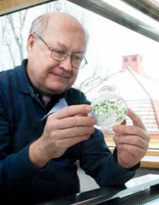Contact
 Professor Hans Ronne
Professor Hans Ronne
Department of Forest Mycology and Plant Pathology
018-673223, hans.ronne@slu.se

All living organisms age. Experiments in yeast, nematodes and mammals have revealed that aging is similarly regulated in different organisms. For example, starvation (caloric restriction) prolongs the lifespan in all organisms that have been tested, which shows that there is a strong link between metabolism and aging.
Yeast cells age just like animal cells, and yeast has therefore been used as a model system to understand aging in animals. The advantage of studying yeast is that it is a eukaryote, and therefore more closely related to animals than bacteria. What is true in yeast is therefore frequently true also in animals. However, yeast is much easier to work with than animal cells. Experiments in yeast can therefore answer questions in a few days that would require months or years of work using mice or human cell cultures.
Yeast cells divide by budding in which a mother cell buds off a daughter cell. A given mother cell can only divide a certain number of times. This is known as replicative aging, and is seen also for human cells, which can divide only a limited number of times. However, the replicative clock is reset in the yeast daughter cell, so a culture of yeast cells has eternal life. Yeast cells that do not replicate will eventually age and die, which is called chronological aging. This is analogous to the progressive deterioration that occurs in non-dividing human cells.
More is known about the mechanisms of aging in yeast than in animals, but many questions remain to be answered. In particular, it is not clear what the connection is between replicative and chronological aging, and why both of them are affected by starvation (caloric restriction).
We are studying the mechanisms in yeast that sense the presence of nutrients, and thus affect aging. There are several nutrient sensing mechanisms, but a key actor is TOR (target of rapamycin). TOR is a protein kinase that phosphorylates other proteins that in turn control gene expression. Rapamycin is a drug that inhibts TOR which is made by a bacterium found on Easter Island. By inhibiting TOR, rapamycin causes the cell to believe that it is starving, and thus delays its aging, even if nutrients are abundant.

Our work has focused on two closely related proteins, Gis1 and Rph1, that function downstream of TOR. Gis1 and Rph1 control gene expression during the transition from growth to stationary phase that takes place when a culture runs out of nutrients. This can be seen as type of starvation or caloric restriction, and several of the proteins that function during the transition to stationary phase, including Gis1, also affects aging of yeast cells.
We have shown that Gis1 and Rph1 jointly regulate a large number of genes during the transition to stationary phase. Interestingly, some of the genes regulated by Gis1 and Rph1 control the metabolism of glycerol and acetic acid, metabolites known to affect aging in yeast. It has thus been found that the accumulation of glycerol delays aging, whereas the accumulation of acetic acid speeds up aging in yeast.
The aim of our project is to study aging in yeast with a focus on the role of Gis1 and Rph1. A better understanding of how aging is regulated in yeast will improve our understanding of aging also in other eukaryotes including man.
Funded by the Swedish Research Council VR
Balciunas, D. and Ronne, H. (2000). Evidence of domain swapping witrhin the jumonji family of transcription factors. Trends in Biochem. Sci. 25, 274-276.
Milan, D., Jeon, J.-T., Looft, C., Amarger, V., Robic, A., Thelander, M., Rogel-Gaillard, C., Paul, S., Iannuccelli, N., Rask, L., Ronne, H., Lundström, K., Reinsch, N., Gellin, J., Kalm, E., Le Roy, P., Chardon, P., Andersson, L. (2000). A Mutation in an AMP-activated Protein Kinase gamma Subunit is Associated with Excess Glycogen in Pig Skeletal Muscle. Science 288, 1248-1251.
Balciunas, D., Hallberg, M., Björklund, S., and Ronne, H. (2003) Functional interactions within the yeast Mediator and evidence of differential subunit modifications. J. Biol. Chem. 278, 3831-3839.
Hallberg, M., Polozkov, G., Hu, G.-Z., Beve, J., Gustafsson, C., Ronne, H. and Björklund, S. (2004) Phosphorylation of the yeast Mediator subunit Med2 by the Srb10 cyclin-dependent kinase. Proc. Natl. Acad. Sci. USA 101, 3370-3375.
Bourbon, H.-M., ... , Ronne, H., ..., Kornberg, R.D. [45 authors] (2004). A unified nomenclature for protein subunits of Mediator complexes linking transcriptional regulators to RNA polymerase II. Mol. Cell 14, 553-557.
Beve, J., Hu, G.-Z., Myers, L. C., Balciunas, D., Werngren, O., Hultenby, K., Wibom, R., Ronne, H. and Gustafsson, C. (2005) The structural and functional role of Med5 in yeast Mediator tail module. J. Biol. Chem. 280, 41366-41372.
Hallberg, M., Hu, G.-Z., Tronnersjö, S., Balciunas, D., Shaikhibrahim, Z., Björklund, S. and Ronne, H. (2006) Functional and physical interactions within the middle domain of yeast Medaitor. Mol. Genet. Genomics 276, 197-210.
Tronnersjö, S., Hanefalk, C., Balciunas, D., Hu, G.-Z., Nordberg, N., Murén, E. and Ronne, H. (2007) The jmjN and jmjC domains of the yeast zinc finger protein Gis1 interact with 19 proteins involved in transcription, sumoylation and DNA repair. Mol. Genet. Genomics 277, 57-70.
Orzechowski Westholm, J., Nordberg, N., Murén, E., Ameur, A., Komorowski, J. amd Ronne, H. (2008) Combinatorial control of gene expression by the three yeast repressors Mig1, Mig2 and Mig3. BMC Genomics 9, online article 601.
Orzechowski Westholm, J., Xu, F., Ronne, H. and Komorowski, J. (2008) Genome-scale study of the importance of binding site context for transcription factor binding and gene regulation. BMC Bioinformatics 9, online article 484.
Kristell, C. Orzechowski Westholm, J. Olsson, I., Ronne, H., Komorowski, J. and Bjerling, P. (2010) Nitrogen depletion in the fission yeast Schizosacharomyces pombe causes nucleosome loss in both promoters and coding regions of activated genes. Genome Research 20, 361-371.
Orzechowski Westholm, J., Tronnersjö, S., Nordberg, N., Olsson, I., Komorowski, J., and Ronne, H. (2012) Gis1 and Rph1 regulate glycerol and acetate metabolism in glucose depleted yeast cells. PLoS One 7:e31577.
Nordberg, N., Olsson, I., Carlsson, M., Hu, G.-Z., Orzechowski Westholm, J. and Ronne, H. (2014) The histone demethylase activity of Rph1 is not essential for its role in the transcriptional response to nutrient signaling. PloS ONE 9, e95078.
 Professor Hans Ronne
Professor Hans RonneDepartment of Forest Mycology and Plant Pathology
018-673223, hans.ronne@slu.se